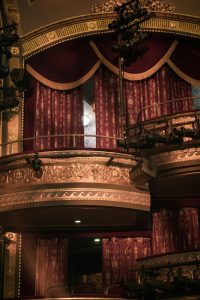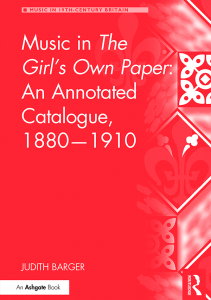Playing Upon Versus Playing With the Organ: The Reception
of the Organ Recital in Victorian England
Part 1
I invite you to put yourselves in the shoes of a nineteenth-century Londoner who, on an August afternoon in 1863, is strolling through South Kensington’s International Exhibition, which had opened earlier the previous year. As you approach the building’s northeast transept, the sounds of an organ drift through the air. You gravitate with the crowd toward the source of the music, an imposing instrument on display built by the firm of Forster and Andrews. The recitalist whom the Victorian audience heard on that occasion was Elizabeth Stirling, who, at age forty-three, was a well-known organist in London. As advertised in The Times, she was playing ‘(by desire) her popular part song “All among the barley,” arranged as a waltz.’ 1
 Elizabeth Stirling (1819 – 1895)
Elizabeth Stirling (1819 – 1895)
London’s 1862 International Exhibition, like the 1851 Great Exhibition in the Crystal Palace, gave England’s organists increased performance opportunities outside the church. Their recitals fueled a debate in the press concerning what music could appropriately be played in this extra-liturgical setting. At the root of the debate was the purpose organ music was expected to fulfil.
Performances by Stirling, who played both at the Crystal Palace in 1857 and at the International Exhibition of 1862, prompted several letters to the editors of England’s music journals. The correspondence offers a means to explore issues surrounding the reception of the organ recital in Victorian England.
A lengthy organ recital by Stirling at the Crystal Palace in October 1857, on a Gray and Davidson instrument, featured three works by Bach, a Handel concerto, a Mendelssohn sonata, an Andante by Wesley and one of her own compositions, the Air with Variations in A Major. 2 Having eagerly arrived at the Crystal Palace to hear Stirling, for whose musical talent she had the highest respect, a correspondent with initials J.J,B. found Stirling subjected to a series of insults. J.J.B. attributed the small and rather unenthusiastic audience to unfavourable weather and the severity of Stirling’s program. But other conduct was not as easily dismissed. To accommodate the Crystal Palace Band concert to follow, Stirling was obliged to begin her recital fifteen minutes earlier than announced. When her program ran longer than expected, the band members allegedly began tuning their instruments in order to bring it to a close. When that ploy failed, they then called ‘Stop – Enough’ and began to hiss, compelling Stirling to end her recital prematurely. 3
Proud that one of her own countrywomen was considered competent to perform in the Crystal palace, J.J.B. was appalled at such treatment of a lady. Her appeal to the editor of the Musical World, who, the correspondent knew, was ‘ever ready to defend the weaker sex, and give them praise and honor where it is due’, elicited two opposite responses. 4 George Grove, Secretary to the Crystal Palace, explained that the cause of the disturbance stemmed from impatient audience members rather than the band, and offered an apology. Given the length of Stirling’s program, he admitted, the band concert should have been scheduled to start thirty minutes later. Grove absolved Stirling of any blame and expressed ‘regret that a lady, and one of such distinguished ability as Miss Stirling, should have been subjected to such an indignity’. 5
The other respondent was not as conciliatory. The audience had assembled for the band concert, not to hear Stirling play, explained a correspondent with the initials W.W., who identified himself as one of the hissers. They had tried all means to stop Stirling’s recital, he explained, such as applauding forcefully to drown her out. They had come to hear music that pleased rather than confounded them. Referring to his perception of the sound of an organ, W.W. concluded: ‘I hope Miss Stirling will take the lesson, and not again weary out the patience of persons who go to the palace for pleasure, and prefer orchestral music to incessant, tuneless, though perhaps scientific noise.’ 6
The organ clearly suffered an image problem in the ears of listeners not accustomed to hearing its music played in recital. Organs were heard in church, where organists played sacred music for the benefit of congregations of worshipers, and on the street where organ grinders cranked out secular tunes to the amusement and annoyance of people within earshot. They also were heard in concert in the shops of organ builders. But the organ had not yet come into its own as a recital instrument.
A major step in the popularization of the organ recital was achieved in the nineteenth century with the building of grand town halls with their magnificent organs in England’s northern cities and elsewhere. According to the Musical Standard, these buildings served as musical centers ‘sanctioning not only interesting but instructive recreation, as a stepping stone to the higher study of art’. 7 Expanding on the possibilities of the organ built for the Glasgow City Hall in 1853, for example, the Musical World claimed:
Those who used to take delight in hearing or practising the current popular music, whether sacred or secular, will, now that the organ has been erected, have an opportunity of listening to the sublime choral harmonies of Handel, Haydn, and Mendelssohn, accompanied by the only single instrument which can give them proper effect, and they will learn to appreciate the solemn and severe grandeur of the world-renowned fugues of Johann Sebastian Bach. 8
Among the cognoscenti, the organ was seen not only as an instrument to impart musical knowledge, but also as one to effect social improvement through the elevation of listeners’ musical taste. 9 Yet although organ recitals slowly were gaining popularity in England, they apparently still could not match the appeal of a rousing band concert.
The most famous of the town hall organ recitals were those at Saint George’s Hall, Liverpool, where W.T. Best presided at the organ for forty years beginning in 1855. Best’s programmes, which were well received, led the Liverpool Mail to conclude after the first year that ‘it is quite possible for the highest class of music, judiciously collected, to please large audiences’. 10
In Best’s programmes, organ arrangements of vocal and instrumental works of the great masters outnumbered pieces originally composed for organ. Audiences were more likely to hear transcriptions of Handel arias and choruses than Handel organ concertos, and to hear the slow movements from Beethoven symphonies arranged for organ rather than Bach organ preludes and fugues. On the lighter side were operatic overtures and ‘reminiscences’ arranged as lengthy fantasias. 11
The ideal mix of serious and lighter music to please an audience was not easily resolved, in part because of the vagaries of musical taste, polarized in the nineteenth century into classical and popular music traditions. Classical music, exemplified in German instrumental music and fugues, could enlighten and educate its listeners but needed an acquired taste to appreciate. Popular music, represented by operatic and dance tunes, entertained and required little knowledge to enjoy. 12 Given their penchant for musical morality, middle-class Victorians for the most part embraced the classical music tradition.
Stirling’s tastes apparently were toward genuine organ music falling within the classical tradition. She especially favoured the music of Bach, though an occasional ‘chestnut’ that audiences had come to expect made its appearance in her recitals. It is thus of particular interest that Stirilng’s organ repertoire at the 1862 International Exhibition sparked a round of letters to the editor of the Musical Standard concerning bad musical taste. The reaction to her choice of pieces serves as a vantage point from which to examine possible pressure on organ recitalists to compromise between two opposing schools of thought. One favoured serious music originally for the organ, the other wanted lighter music with more entertainment value. This is the topic of the next Blog.
Notes
1 ‘Miss E. Stirling’, The Times (London), 12 Aug 1862, 1d.
2 ‘Crystal Palace: Organ Performance’, The Times (London), 9 Oct 1857, 1b.
3 J.J.B., ‘Miss Elizabeth Stirling at the Crystal Palace’ [correspondence], Musical World 35 (17 Oct 1857): 663; George Grove, ‘Miss Stirilng at the Crystal Palace’ [correspondence], and W.W., ‘Miss Stirling at the Crystal Palace’ [correspondence], both Musical World 35 (24 Oct 1857): 679; and J.J.B., ‘Miss Stirling at the Crystal Palace’ [correspondence], Musical World 35 (31 Oct 1857): 695.
4 J.J.B., ‘Miss Elizabeth Stirling’, 663.
5 George Grove, ‘Miss Stirling’, 679.
6 W.W., ‘Miss Stirling’, 679.
7 ‘Town Hall Organs and Borough Organists’, Musical Standard n.s. 14 (23 Mar 1878): 180.
8 ‘Glasgow City Hall Organ’, Musical World 31 (29 Oct 1853): 691.
9 Nicholas Thistlethwaite, ‘Sebastian and the Steam Trumpet’, Organ 56 (Oct 1977): 80.
10 ‘The Organ Recitals at St. George’s Hall’, Liverpool Mail, 6 Sep 1956, 3e.
11 Ibid.
12 William Weber, ‘Mass Culture and the Reshaping of European Musical Taste, 1770–1870’, International Review of the Aesthetics and Sociology of Music 8 (Jun 1977): 16–17.
To be continued



